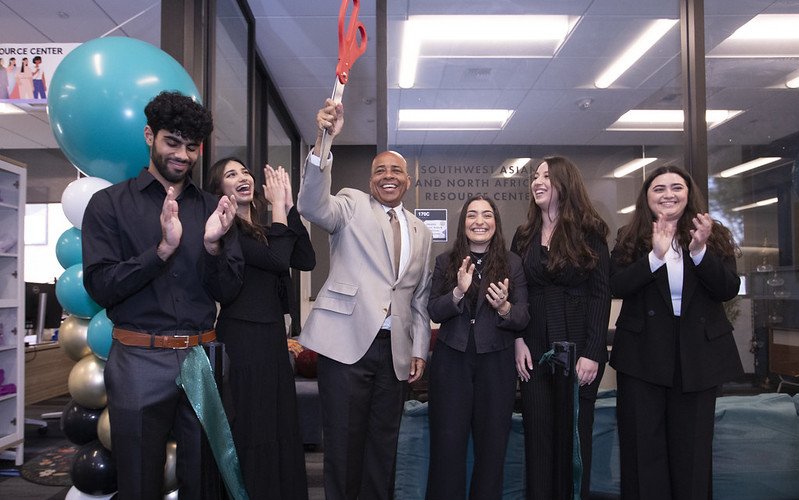
Graduate student Bellar Naber called the opening of Cal State Fullerton’s Southwest Asian and North African Resource Center “a dream in the making for a long time.”
“What began as heartfelt conversations between students turned into organizing, advocating, meeting with campus leaders, and most importantly, holding on to a vision,” said Naber, a student assistant at the center.
Originally from Jordan, Naber said that vision is a space where all students can unite, celebrate culture, find support and build community.
“This is more than just a physical space,” said Naber, a Class of 2025 grad, earning a master’s degree in higher education. “It’s a reflection of our resilience, our pride and our stories. It’s a place for joy, healing, connection, and for dreaming boldly about what comes next.”
CSUF President Ronald Rochon welcomed campus and community members to the April 21 opening celebration of the SWANA Resource Center in Pollak Library. CSUF is one of two California State University campuses to open a SWANA center for students.
Open to all students, the center is part of the Diversity Initiatives and Resource Centers and was made possible after years of student-led advocacy and donor support.
Rochon lauded the students and donors, including alums Mary Chammas and Diane Shammas, who spearheaded efforts to open the center.
“I am humbled, excited and thankful to be here to celebrate this important milestone,” Rochon said.
“For everyone who walks through that door, help them to understand the significance of the ancestors who came before us, who dreamt about you all being here today.”
Shammas, a Lebanese American scholar who studied cultural anthropology focusing on the Middle East and North Africa as a CSUF graduate student, is the center’s first and largest donor.
“Diane has been an instrument of change, vision and fortitude by providing so many resources, both economic and intellectual, to make this happen,” Rochon said.
Shammas earned a master’s degree in anthropology in 1985 and holds a doctorate in international, intercultural and urban higher education from USC.
Her father was Lebanese, and her mother was Swedish. Growing up, Shammas said classmates often questioned her ethnicity, which can be an isolating experience for SWANA students.
Shammas’ desire to support the center and students is simple: “I wanted a home for people who identify as SWANA to have a place they could call their own on campus.”
Chammas ’23 (B.A. international business-global trade) spoke about how she and several members of the SWANA community advocated for the center as a place that reflects their cultural identity and experiences. She also helped to create the new SWANA minor and establish the SWANA student organization.
“This center didn’t just give us a space. It gave us a reason to stay, show up, and feel proud of who we are,” said Chammas, a Southwestern Law School student.
“This wasn’t just about getting a room. It was about being seen. It was about creating a space where we could show up as our full selves — loud, layered, complicated and proud. We turned a dream into a doorway.”
Beyond serving SWANA students, Chammas said the center is key in educating the campus community.
“The SWANA region is vast, diverse and deserving of its own recognition,” she said. “Each country has unique histories, languages, religions and cultural norms. Educating others about that is a powerful tool for breaking down stereotypes and fostering inclusion.”
